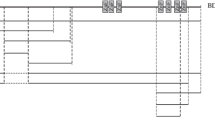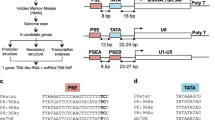Abstract
The Drosophila melanogaster TRF2 protein regulates transcription of several genes. The trf2 gene structure was studied. The gene proved to code for two protein isoforms, a known 75-kDa isoform and a newly identified 175-kDa isoform. The new isoform combines the known isoform sequence with an extended N end containing a coiled-coil motif. The long TRF2 isoform was found to act as a component of a multiprotein complex, including ISWI ATPase as well.
Similar content being viewed by others
References
Stoneley, M. and Willis, A.E., Cellular Internal Ribosome Entry Segments: Structures, Trans-Acting Factors and Regulation of Gene Expression, Oncogene, 2004, vol. 23, pp. 3200–3207.
Bell, B. and Tora, L., Regulation of Gene Expression by Multiple Forms of TFIID and Other Novel TAFII-Containing Complexes, Exp. Cell Res., 1999, vol. 246, pp. 11–19.
Hochheimer, A. and Tjian, R., Diversified Transcription Initiation Complexes Expand Promoter Selectivity and Tissue-Specific Gene Expression, Genes Dev., 2003, vol. 17, pp. 1309–1320.
Muller, F. and Tora, L., The Multicoloured World of Promoter Recognition Complexes, EMBO J., 2004, vol. 23, pp. 2–8.
Dantonel, J.C., Wurtz, J.M., Poch, O., et al., The TBP-Like Factor: An Alternative Transcription Factor in Metazoa?, Trends Biochem. Sci., 1999, vol. 24, pp. 335–339.
Rabenstein, M.D., Zhou, S., Lis, J.T., and Tjian, R., TATA Box-Binding Protein (TBP)-Related Factor 2 (TRF2), a Third Member of the TBP Family, Proc. Natl. Acad. Sci. USA, 1999, vol. 96, pp. 4791–4796.
Fuller, M.T., Genetic Control of Cell Proliferation and Differentiation in Drosophila Spermatogenesis, Semin. Cell Dev. Biol., 1998, vol. 9, pp. 433–444.
Martianov, I., Brancorsini, S., Gansmuller, A., et al., Distinct Functions of TBP and TLF/TRF2 during Spermatogenesis: Requirement of TLF for Heterochromatic Chromocenter Formation in Haploid Round Spermatids, Development, 2002, vol. 129, pp. 945–955.
Spradling, A.C., Developmental Genetics of Oogenesis, Drosophila Development, Bate M., Martinez-Arias A., Cold Spring Harbor, New York: Cold Spring Harbor Press, 1993, pp. 1–70.
Jin, J.S., Baek, S., and Lee, H.A., DNA Replication-Related Element Downstream from the Initiation Site of Drosophila Selenophosphate Synthetase 2 Gene Is Essential for Its Transcription, Nucleic Acids Res., 2004, vol. 32, pp. 2482–2493.
Hernandez, G., Vazquez-Pianzola, P., and Sierra, J.M., Internal Ribosome Entry Site Drives Cap-Independent Translation of Reaper and Heat Shock Protein 70 mRNAs in Drosophila Embryos, RNA, 2004, vol. 10, pp. 1783–1797.
Ohbayashi, T., Makino, Y., and Tamura, T.A., Identification of a Mouse TBP-Like Protein (TLP) Distantly Related to the Drosophila TBP-Related Factor, Nucleic Acids Res., 1999, vol. 27, pp. 750–755.
Georgieva, S., Kirschner, D.B., Jagla, T., et al., Two Novel Drosophila TAF(II)S Have Homology with Human TAF(II)30 and Are Differentially Regulated during Development, Mol. Cell. Biol., 2000, vol. 20, pp. 1639–1648.
Sandaltzopoulos, R., Quivy, J.P., and Becker, P.B., Analysis of Protein/DNA Interactions by Solid-Phase Foot-printing, Methods Mol. Cell. Biol., 1995, vol. 5, pp. 176–181.
Moore, P.A., Ozer, J., Salunek, M., et al., A Human TATA Binding Protein-Related Protein with Altered DNA Binding Specificity Inhibits Transcription from Multiple Promoters and Activators, Mol. Cell. Biol., 1999, vol. 19, pp. 7610–7620.
Lin, H. and Spradling, A.C., Germline Stem Cell Division and Egg Chamber Development in Transplanted Drosophila Germaria, Dev. Biol., 1993, vol. 159, pp. 140–152.
Modestova, E.A., Kopytova, D.V., Georgieva, S.G., and Simonova, O.B., P-Ph-Mediated Repression of the Leg-Arista-Wing Complex Gene Transcription in Drosophila, Russ. J. Genet., 2003, vol. 39, no. 5, pp. 588–591.
Kim, Y., Geiger, J.H., Hahn, S., and Sigler, P.B., Crystal Structure of a Yeast TBP/TATA-Box Complex, Nature, 1993, vol. 365, pp. 512–520.
Author information
Authors and Affiliations
Corresponding author
Additional information
Original Russian Text © D.V. Kopytova, Yu.V. Nikolenko, L.A. Lebedeva, E.N. Nabirochkina, Yu.V. Shidlovskii, S.G. Georgieva, A.N. Krasnov, 2008, published in Genetika, 2008, Vol. 44, No. 2, pp. 163–169.
Rights and permissions
About this article
Cite this article
Kopytova, D.V., Nikolenko, Y.V., Lebedeva, L.A. et al. Study of the Drosophila melanogaster trf2 gene and its protein product. Russ J Genet 44, 131–136 (2008). https://doi.org/10.1134/S1022795408020026
Received:
Published:
Issue Date:
DOI: https://doi.org/10.1134/S1022795408020026




